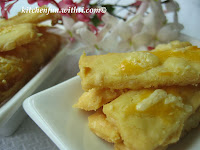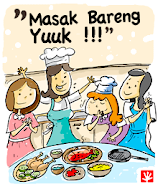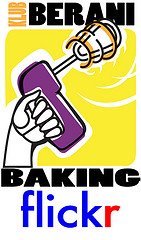 I made this cake special for my Mothers group, im glad that they like it, sweet.... i used my chocolate almond cake, with Chocolate ganache for topping and Chocolate stick mint, No body can resist ;)
I made this cake special for my Mothers group, im glad that they like it, sweet.... i used my chocolate almond cake, with Chocolate ganache for topping and Chocolate stick mint, No body can resist ;)
Wednesday, October 31, 2007
Chocolate Cake
 I made this cake special for my Mothers group, im glad that they like it, sweet.... i used my chocolate almond cake, with Chocolate ganache for topping and Chocolate stick mint, No body can resist ;)
I made this cake special for my Mothers group, im glad that they like it, sweet.... i used my chocolate almond cake, with Chocolate ganache for topping and Chocolate stick mint, No body can resist ;)
Tuesday, October 30, 2007
All about Pasta
 Angel Hair Spaghetti: A thin, very delicate, long pasta, its perfect for using with delicate sauces, such as light cream and salmon or white wine and shellfish.
Angel Hair Spaghetti: A thin, very delicate, long pasta, its perfect for using with delicate sauces, such as light cream and salmon or white wine and shellfish.
Fettucine: 5mm-wide ribbon shaped, butter and cream based sauces are good with this pasta shape.
Farfalle: A butterfly shaped pasta, also called bowtie pasta, works well with light sauces, such as fish in wine and cream, or robust sauces such as cheese, and chunky tomato and herb.
Fusilli: The twisted shape of Fusilli holds bits of meat, vegetables and cheese, so this shape works well with any sauce.
Macaroni: Macaroni are ridged, hollow tubes which are cut flat at the ends. This is a very versatile shape which can be used in a variety of ways, with toppings, in salads or in bakes.
Penne: Penne is very popular slanted-edged, tubular pasta shape that suits many sauces. Try with a spicy tomato or a creamy mushroom sauce.
Risoni: Small rice-shaped beads of pasta. Use Risone in soups or you can stuff capsicums or eggplants with a mixture of cooked risone, cheese and sauce.Veg Twist: A colourful alternative to plain twist shapes. Made from wheat, spinach or tomato flavours, this pasta shape works well in salad.
Shells: This pasta is a great team with a tomato and veg sauce, or to use in pasta salads and pasta bakes that are cheese or tomato based.
How To Cook Pasta:Cooking dried pasta: Gradually add pasta to a large saucepan of boiling water, making sure water does not go off the boil. When cooking " long" pasta, such as spaghetti, hold strands at one end until the submerged end becomes soft in the water. Gradually lower strands, cooling them neatly. Boil until "al dente" (tender but firm), stirring occasionally so pasta does not stick to base of pan.
Pasta should only be rinsed after draining if being used in a cold dish or if not being served immiediately. In this cases, rinse pasta under cold,running water to stop cooking process, then drain. Uncooked dried pasta can be stored for up to a year in a cool,dry place. Cooked pasta can be refrigerated, covered, for two days.
Cooking Fresh Pasta: Fresh pasta is cooked in much same way as dried pasta, however it requires less cooking time. Gradually add fresh pasta to a large saucepan of boiling water, making sure water does not go off the boil. Boil until pasta is al dente. It will only take a few minutes,so check pasta regularly to ensure it does not overcook. Cooking times for pasta will vary according to individual pastas. (credits for: Australian Table magazine)
Facts About Pasta
History of Pasta has been an Italian tradition for hundreds of years. To passionate Italians, pasta is poetry. They're so devoted to their national dish, there's even a pasta museum in Pontedassio, Italy, filled with antique pasta-making implements and dried specimens of pasta dating back 100 years. The Italian, Marco Polo, has been given credit for introducing pasta to Italy. However, there's evidence that the ancient Etruscans in Italy were eating pasta at least 1600 years before Marco Polo was born. Furthermore, the Chinese are known to have been eating a "noodle-like food" as early as 3000 BC. It is also believed that the Ancient Greeks, Romans and even Arabs had discovered the simple delights of pasta long before Marco Polo was around. In fact, Greek mythology suggests that the Greek God 'Vulcan' invented a device that made "strings of dough". Whatever its origin, there is no doubt that even if pasta wasn't invented in Italy, it was certainly the Italians who perfected the art of pasta making. Dried pasta became popular through the 14th and 15th Centuries, as it could be easily stored on ships setting out to explore the New World. Various types of pasta, including long hollow tubes, are mentioned in the 15th Century records of Italian and Dominican monasteries. By the 17th Century, pasta had become part of the daily diet throughout Italy because it was economical, readily available and versatile.
Thomas Jefferson has been credited with bringing the first "macaroni" maker to America in 1789, but full advent of electricity in the 1900's made life a lot easier for the pasta industry. Machines took over the labour intensive chores like mixing the dough and cutting the shapes. History of Pasta Shapes & Sauces. Many pasta sauces have a long and interesting history. Legend has it that the traditional cream and cheese sauce, Alfredo, takes its name from its creator, a Rome restaurateur called Alfredo. Carbonara sauce was believed to be devised during World War 2, when American soldiers in Italy asked for bacon and eggs for breakfast. The Italians compromised by creating a bacon, egg and cream pasta sauce. And everyone's favourite, Bolognese, originated from the region of Bologna in Italy.
The meaning of 'al dente' 'Al dente' is used to describe when pasta is cooked to perfection. 'Al dente' in Italian literally means "to the tooth". Pasta that is al dente should not be overly firm, nor should it be overly soft. This is often difficult to measure in minutes, as factors such as the temperature of the water, the size of the pot etc will affect the length of time that is required to cook the pasta. San Remo therefore recommends that the product is tested prior to deciding if it is ready. (credits to san Remo Pasta).
Pasta is a type of of food made from a dough using flour, water and/or eggs. The dough is shaped and can be stored. Pasta is boiled prior to consumption. There are many variations of shapes and ingredients that are all called pasta. Some English speakers say that pastas are a type of noodle. A few examples include Spaghetti(solid cylinders), macaroni (tubes or hollow cylinders), lasagne (sheets).
Pasta can also denote dishes in which pasta products are the primary ingredient, served with sauce or seasonings. The word comes from Italian pasta which shares its origins with "paste", meaning "dough", "pasta", or "pastry" as in "small cake". As recently as 1918 the English word "paste" was used instead of or alongside the Italian pasta.(Wikipedia).
Sunday, October 28, 2007
My Cake Project




Its been a long time i want to try using edible image on the birthday cake. I have been searching on the internet to find how to attach the icing sheet. I was finally brave enough to make this birthday cake. I used sponge cake and butter cream to cover the cake, some royal icing and small candies to decorate. Im so glad I made it and Im satisfied with the result, so next time I'll be more confident. So what do you think?.
Monday, October 22, 2007
Chocolate Cup Cakes (again)


 Its quite a while since i made my chocolate cup cakes ( i remenber it was fathers day!), but nothing special happening today, just feel like chocolate cakes, but i shouldn't eat in front of my baby , even though she's only 11 months but she understand most of food :)! she's eating a lot! (sorry sweetheart, i know you want it but you can't have it yet), i know if she grown up she'll be chocolate addict just like her parents.
Its quite a while since i made my chocolate cup cakes ( i remenber it was fathers day!), but nothing special happening today, just feel like chocolate cakes, but i shouldn't eat in front of my baby , even though she's only 11 months but she understand most of food :)! she's eating a lot! (sorry sweetheart, i know you want it but you can't have it yet), i know if she grown up she'll be chocolate addict just like her parents. Friday, October 19, 2007
Pancakes

- 1 cup (125 gr) plain flour
- 1 tablespoon baking powder
- 2 tablespoon caster sugar
- 1 cup (250 ml) skim milk
- 2 eggs, beaten
- 2 tablespoon butter, melted
- 1/2 teaspoon Vanilla essence
Maple syrup or jam to serve
- Sift the flour, baking powder,sugar and a pinch of salt into a bowl. Whisk together the milk, egg, butter and vanilla essence. Whisk the milk mixture into the flour mixture until a smooth batter is formed.
- Heat and lightly grease a large non-stick frying pan. Pour in 2 tablespoon of batter, four at a time, and cook for 2 minutes, or until bubbles appear. Cook the other side. This will make 24 pancakes.
- Serve hot with maple syrup or jam.
Thursday, October 18, 2007
kaastengels ( cheese stick)



Kaastengels
- 125 Salted butter
- 2 egg yolks
- 25 gr cornstarch
- 150 gr ( 1 cup) plain flour
- 100 g grated old/matured Edam/Gouda Cheese
- ¼ teaspoon baking powder
Sprinkle: 1 egg yolk, 50 g grated cheddar cheese
- Preheat oven to 180 degrees C.
- Mix butter, egg yolks with a mixer then add the grated matured cheese.
- Knead in the mixture together with flour,cornstarch and baking powder.
- Roll the dough and cut into small rectangles about 1x3 cm.
- Place rectangles onto grease trays. Brush each one with the egg yolk and sprinkle with grated cheddar.
- Bake for 15-20 minutes or until lightly brown.
Almond Shortbreads (Kue Putri Salju)

Almond Shortbreads
- 250 gr Butter
- 100 gr Caster sugar
- 1 egg yolk
- 1 tsp vanilla essence
- 1/2 tsp baking powder
- 200 gr Almond meal, roasted, cooled
- 250 gr plain flour
60 gr Icing Sugar , to dust
- Preheat oven to 170 Degrees
- Place butter and sugar in a large bowl, and beat with an electric mixer for 3 mins, until pale and fluffy.
- Sift flour over bowl, add almond meal and knead for 1 minutes, gently roll a portion onto a lightly floured surface to thickness of 5 mm (1/4 inch), cut out shapes with cutter.
- Bake for 15-20 mins, or until lightly golden.
- Allow to cool in the trays.
- Dust with icing sugar.
Wednesday, October 10, 2007
Saturday, October 6, 2007
Corn flake Cookies



I took this recipe from Kellogg's carton box
Corn Flakes Cookies
(makes 30)
2 cups sifted flours
1/2 tsp baking powder
250 gr margarine
1 cup sugar
1 tsp vanilla flavouring
1 1/2 cup Corn Flakes
Preheat oven to 180 degrees C, sift together flour and baking powder.
Beat margarine & sugar together until light and fluffy.
Add eggs & vanilla, beat well.
Add sifted dry ingredients & corn flakes, mix well for about 2 minutes.
Drop by tablespoon onto ungreased baking sheets.
Bake in the oven for about 10 minutes or until lightly browned.
Wednesday, October 3, 2007
Fresh Orange Jellies



Fresh Orange Jellies
3 orange
1 1/2 tbsp gelatine powder
1/2(125 ml) boiling water
2 tbsp sugar
Halve oranges lengthways ans squeeze juice. Scoop out and discard flesh, keeping skin intact.
Pour 1/4 cup water into a small saucepan ans sprinkle over gelatine. Heat on low and stir until gelatine dissolves.
Add strained orange juice, boiling water and sugar and stir until thoroughly mixed.
Cool slightly. Pour into orange halves and chill for 3 hours, until set. Cut into wedges. (from Table magazine, Nov 2006)
Monday, October 1, 2007
Chocolate Mousse



This recipe originally named Chocolate rum Mousse (add rum 2tsp)
Source: Sweet food book
Chocolate Mousse
- 250 gr good -quality dark chocolate, chopped
- 3 eggs
- 60 gr caster sugar
- 250 ml whipping cream
- whipped cream,extra, to serve
- dark chocolate, extra, grated to garnish
- Put the chocolate in a heatproof bowl. Half fill a saucepan with water and bring to boil. Remove from the heat and place the bowl over the pan, making sure it is not touching the water, stir occasionally until the chocolate has melted. Leave to cool.
- Using electric beaters, beat the eggs and sugar in a bowl for 5 minutes, or until the mixture is thick, pale and increased in volume. Transfer to a large bowl.
- Using metal spoon, fold in the melted chocolate (with rum), leave the mixture to cool, then gently fold in the lightly whipped cream until just combined.
- Spoon into four 250 ml ramekins or dessert glasses. Refrigerate for 2 hours, or until set. Serve with extra whipped cream and garnish with grated chocolate. (serves 4)



























